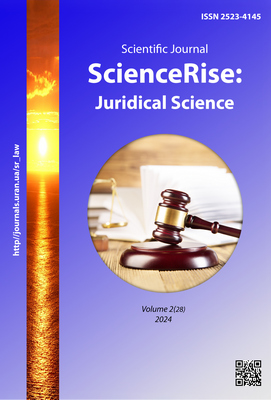European experience in counteracting disinformation influences
DOI:
https://doi.org/10.15587/2523-4153.2024.309074Keywords:
security, threats, disinformation, national/state security, information security, information and communication technologies, information-psychological influences, information warfareAbstract
Information-psychological influences, attacks, and operations do not have a physical manifestation but generate destabilizing internal and external processes within a state. These processes cause aggression, anxiety, and dissatisfaction among the population, potentially leading to open physical conflict. The use of the Internet enables extremist organizations to access mass media, spreading propaganda, informing about their goals, tasks, measures, and forms of support. The authors emphasize the significant impact of modern information and communication technologies on increasing threats to political stability and the security of any state. The aim of this paper is to highlight foreign experiences regarding organizational and legal measures that prevent the spread of disinformation, aimed at inciting hostility and hatred within a state. The study draws on experiences from large-scale protest actions, organized and coordinated through social networks on the Internet. The authors note that blogs, social networks, electronic maps, and video hosting sites are currently used without restrictions for political destabilization. Social networks enable immediate support from like-minded individuals and the publication of extremist materials, which contribute to the escalation of socio-political, ethnic, and interfaith conflicts. The main research methods are comparative analysis, statistical method, historical method, structural-functional method of cognition. Having studied the periods of formation of the system for countering the spread of disinformation in the EU, the authors concluded that the work on countering the spread of disinformation is conducted comprehensively and systematically and is constantly being improved in accordance with the challenges. In the EU countries, not only the practice of combating disinformation has been developed, but also an array of normative legal acts has been adopted to prevent the spread of disinformation. The European experience demonstrates the importance of a balance between freedom of speech and security measures in the information space. Such a comprehensive and conceptual approach should be the basis for creating a system for countering the spread of disinformation in Ukraine.
References
- Top 10 trends of 2014: 10. The Rapid Spread of Misinformation Online (2014). World Economic Forum.
- Communication from the Commission to the European Parliament, the Council, the European Economic and Social Committee and the Committee of the Regions Tackling Online Disinformation: a European Approach. COM/2018/236 final (2018). Eur-Lex. Available at: https://eur-lex.europa.eu/legal-content/EN/TXT/?uri=CELEX%3A52018DC0236
- McCuen, J. J. (2008). Hybrid Wars. Military Review. Fort Leavenworth: Combined Arms Center. March-April, 107–113. Available at: https://www.armyupress.army.mil/Portals/7/military-review/Archives/English/MilitaryReview_20080430_art017.pdf
- Polska, K. (2024). Doslidzhennia: Rosiia – holovnyi dezinformator u YeS. Available at: https://www.dw.com/ru/issledovanie-rossia-glavnyj-rasprostranitel-dezinformacii-v-es/a-69089063
- Van der Linden, T. (2024). AI: We Need Another Hero. ALTI Amsterdam. Available at: https://alti.amsterdam/ai-we-need-another-hero/
- de Hingh, A. E., Lodder, A. R. (2017). Informatieveiligheid: de digitale veerkracht van Nederlandse overheden. Bestuurskunde, 26 (1), 27–34. https://doi.org/10.5553/bk/092733872017026001005
- The Doppelganger case assessment of Platform Regulation on the EU Disinformation Environment (2024). Riga. Available at: https://stratcomcoe.org/pdfjs/?file=/publications/download/The-Doppelganger-Case-DIGITAL.pdf?zoom=page-fit
- Fon Klauzevits, K. (2023). Naivazhlyvishi pryntsypy vedennia viiny. Arii, 384.
- Dobber, T., Kruikemeier, S., Helberger, N., Goodman, E. (2023). Shielding citizens? Understanding the impact of political advertisement transparency information. New Media & Society. https://doi.org/10.1177/14614448231157640
- Arquilla, J. (2007). Information strategy and warfare: a guide to theory and practice. Available at: https://ocul-yor.primo.exlibrisgroup.com/discovery/fulldisplay?docid=alma991000892449705164&context=U&vid=01OCUL_YOR&lang=enT
- The Strengthened Code of Practice on Disinformation (2022). Available at:https://disinfocode.eu/wp-content/uploads/2023/01/The-Strengthened-Code-of-Practice-on-Disinformation-2022.pdf
- Baines, P., O’Shaughnessy, N., Snow, N. (2020). The SAGE Handbook of Propaganda. SAGE Publications Ltd. https://doi.org/10.4135/9781526477170
Downloads
Published
How to Cite
Issue
Section
License
Copyright (c) 2024 Alla Kovalchuk, Bogdana Cherniavska

This work is licensed under a Creative Commons Attribution 4.0 International License.
Our journal abides by the Creative Commons CC BY copyright rights and permissions for open access journals.
Authors, who are published in this journal, agree to the following conditions:
1. The authors reserve the right to authorship of the work and pass the first publication right of this work to the journal under the terms of a Creative Commons CC BY, which allows others to freely distribute the published research with the obligatory reference to the authors of the original work and the first publication of the work in this journal.
2. The authors have the right to conclude separate supplement agreements that relate to non-exclusive work distribution in the form in which it has been published by the journal (for example, to upload the work to the online storage of the journal or publish it as part of a monograph), provided that the reference to the first publication of the work in this journal is included.









